Updated 13 Jan 2011
|
WIRKSWORTH Parish Records 1600-1900
|
|
Margery Whitham supplied this scan of a very early scouting
photo at Cromford. Anyone who knows more about it, please
contact  , see emails. , see emails.
|
The photo shows 17 scouts with 1 scout master. The master looks about 25,
the boys about 12-14.
I was never a boy scout, can anyone who was tell me of any points of
interest on this photo?
The boys seem to be equipped with original scouting uniform.
("The original uniform, which has created a familiar image in the public
eye and had a very military appearance, consisted of a khaki button-up
shirt, shorts, and a broad-brimmed campaign hat"- Wikipedia).
One boy has a folding knife hanging from his belt, one holds a map.
They have shorts, mugs, high socks, boots and dark shirts
with pockets, and low-crown campaign hats.
The scout master has no special uniform. Could they be from a school?
The railings and woods in the background look as though the group of
scouts may have been in the grounds of Alderwasley Hall, in the 'reign'
of Francis Cecil Albert HURT (1878-1930), can anyone recognize where?
The scouting movement was only started in 1907, Baden-Powell's book
published in 1908, and girl guides started in 1910, so this 1909
photograph may be of the first year of scouting at Cromford.
All these people are probably in the 1901 Census, it would be great to
identify them.
|
Inscribed on front "Cromford Scouts". Dated on rear "August 1909".
Possibly in Alderwasley Estate.
Notice: 17 boy scouts, 1 scoutmaster, Union flag on flagpole,
staves, groundsheet, cookingpot, woodland and iron estate railings
"Almost immediately
we saw at holiday times on the roads of Britain little troops and patrols
of Boy Scouts, big and small, staff in hand, trudging forward hopefully,
pushing their little handcart with their kit and camping gear towards
the woodlands and parklands which their exemplary conduct speedily threw
open to them." ("B-P" by Winston Churchill)
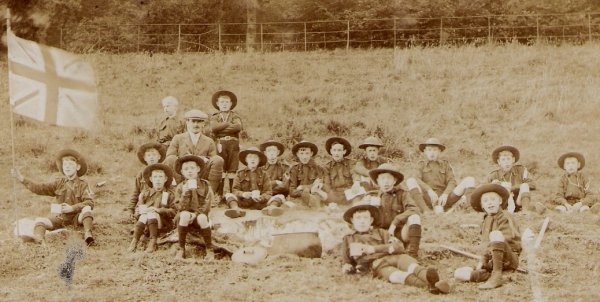
|
Enlargement of main photo.
The photo owner's Uncle Bertram Parker is sitting,
4th from right, arms folded, chin strap visible.
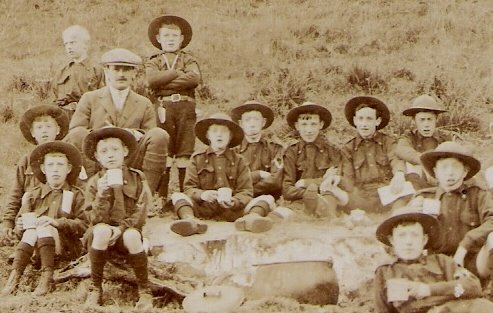
|
Notice: Cookingpot, saucepan lid, groundsheet, enamelled mugs, lanyards,
low-crown campaign hats, nailed boots, button-down shirts,
chest pockets, maps, shorts, belts and scout knife. Are they drinking soup?
|
Scoutmaster
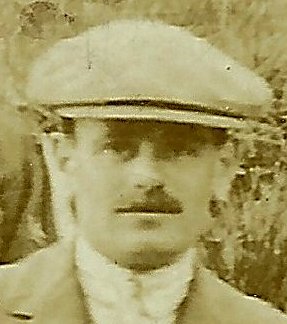
|
Scout's webbing belt, buckle, clip and knife

|
Scout knife:
On one side, a single heavy blade.
On the other, a marlin- spike, used
by seamen for ropework, but became famous
when used by boy scouts for getting
stones out of horses' hooves. The
webmaster had a similar knife, much loved,
but he lost it.
|
Marlinspike knife.
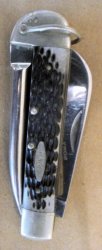
|
"SCOUT UNIFORM"
"The Scout Uniform is very like the uniform worn by my men when I commanded the South African Constabulary. They knew what was comfortable, serviceable, and a good protection against the weather. So Scouts have much the same uniform.
"With a few minor alterations the original Scout Uniform has met the ideas of Scouts around the world and has been universally adopted. Of course, in extreme climates it has to be modified to suit the seasons, but on the whole the different nations in the temperate climates are dressed uniformly alike.
"Starting at the top, the broad-brimmed khaki hat is a good protection from sun and rain. It is kept on by a bootlace tied in a bow in front on the brim and going round the back of the head. This lace will come in handy in many ways when you camp. The hat has four dents in it.
"Then comes the scarf or neckerchief which is folded into a triangle with the point at the back of the neck. Every Troop has its own scarf colour, and since the honour of your Troop is bound up in the scarf, you must be very careful to keep it clean and tidy. It is fastened at the throat by a knot, or "woggle", which is some form of ring made of cord, metal, or bone, or anything you like. The scarf protects your neck from sunburn and serves many purposes, such as for a bandage or as an emergency rope.
"The Scout shirt (or jersey) is a free-and-easy thing, and nothing could be more comfortable when the sleeves are rolled up. All Scouts have them rolled up because this tends to give them greater freedom, but also as a sign that they are ready to carry out their Motto. They only roll them down when it is very cold or when their arms may become sunburnt. In cold weather the shirt can be supplemented with warmer garments over or, better, under it.
"Shorts are essential to hard work, to hiking and to camping. They are less expensive and more hygienic than breeches or trousers. They give freedom and ventilation to the legs. Another advantage is that when the ground is wet, you can go about without stockings and none of your clothes gets damp.
"The stockings are held up by garters, with green tabs showing below the turnover of the stocking top.
"Personally, I consider shoes more suitable than high boots since they give better ventilation to the feet and therefore diminish the danger of chills and of chafes which come from damp stockings softening the feet when tightly laced boots are worn.
|
Boy Scout showing uniform and staff from the 1910s.
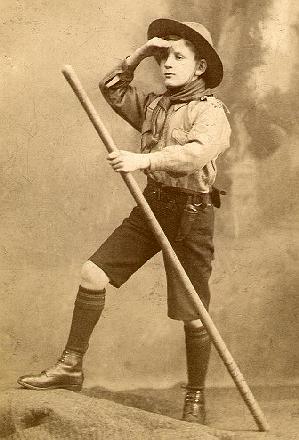
|
"WEARING THE UNIFORM"
"The Scout kit, through its uniformity, now constitutes a bond of brotherhood among boys across the world.
"The correct wearing of the Uniform and smartness of turnout of the individual Scout makes him a credit to our Movement. It shows his pride in himself and in his Troop.
"One slovenly Scout, on the other hand, inaccurately dressed may let down the whole Movement in the eyes of the public. Show me such a fellow and I can show you one who has not grasped the true Scouting spirit and who takes no pride in his membership of our great Brotherhood."
"Campfire Yarn No.3. Becoming a Scout."
Baden-Powell, Scouting for Boys, 1908.
|
It was in 1907 that B.-P. held his first camp for boys to learn the lore
of the backwoods and the discipline of Scout life. Twenty-one boys of
every class from the East End of London, from Eton and Harrow, pitched
their little tents on Brownsea Island in Dorsetshire. From this modest
beginning sprang the world-wide movement of Boy Scouts and girl guides,
constantly renewing itself as the years pass, and now well over two
million strong.
In 1908 the Chief Scout, as he called himself, published his book,
Scouting for Boys. It appealed to all the sense of adventure and love
of open-air life which is so strong in youth. But beyond this it stirred
those sentiments of knightly chivalry, of playing the game - any game -
earnest or fun - hard and fairly, which constitute the most important
part of the British system of education.
Success was immediate and far-reaching. The simple uniform, khaki shorts
and a shirt - within the range of the poorest - was founded upon that
of General Baden-Powell's old corps, the South African Constabulary.
The hat was the famous hat with the flat brim and pinched top which he
had worn at Mafeking.
The motto "Be Prepared" was founded on his initials. Almost immediately
we saw at holiday times on the roads of Britain little troops and patrols
of Boy Scouts, big and small, staff in hand, trudging forward hopefully,
pushing their little handcart with their kit and camping gear towards
the woodlands and parklands which their exemplary conduct speedily threw
open to them. Forthwith there twinkled the camp fires of a vast new army
whose ranks will never be empty, and whose march will never be ended
while red blood courses in the veins of youth.
"B-P", Great Contempories
by Winston Churchill, 1938
|
A scout handcart
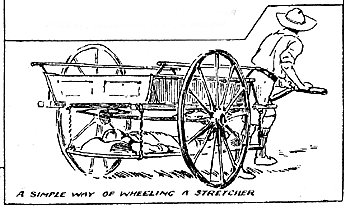
|
1808 1810
Joseph 1837 Fanny
BRITLAND=====v=====STENDALL
1871 | 1891
|
|--------|-----|-----|----|--------|
| | | | |
1839 1842 | 1849 1852
Charles John | William Lydia
|
1833 1844
Thomas 1864 Elizabeth
PARKER=====v=====BRITLAND
1892 | 1908
|
|----|-------|----|---|------|---------|
| | | | | |
| 1869 1871 1874 1877 1881
| Fanny Joseph Mary William Kezia
|
1867 1871 Mary
Francis 1894 Elizabeth George 1877 Ellen
PARKER=====v=====WRIGHT PETTS=====v=====HATFIELD
1925 | |
|----|-----|--------| |
| | | |
| 1897 1900 |
| Doris Alice |
1895 |
Bertram 1899
Francis 1919 Edith
PARKER=============v=============PETTS
|
----Anyone with more details for publication on this webpage,
please email  ---- ----
------------------
Lynda Hardy writes
Hi John
First let me say what a wonderful site yours is!
I have just seen the article about the Cromford scouts 1909 submitted by
Marjory Witham (Photo 622) and realised that Bertrand Francis Parker was
married to my Great Aunt Edith Petts. She was born in 1899 at Alderwasley
daughter of George Petts and Mary Ellen Hatfield. I have spoken to my father
today and he being 84 can remember Bertrand living at the School House in
Cromford he thought because his wife Edith was caretaker at the school. He
can also remember being taken to Cromford Fair as a child with his parents
and visiting the Parkers in a house on the corner of the market place to
the right of the front of the Greyhound Inn. Whether this was before the
school house or after he is not sure. Dad's father - Oscar Snow - married
Mary Petts sister to Edith.
Kind regards
Linda Hardy
------------------
Hello John,
Firstly my mistake - his name is Bertrand Francis, not Bertram.
The photo looks very good on your site - let us hope it helps someone.
Bertrand attended Cromford C of E School until 1908 when he left to work
at Lea Mills. I know that at one time the Parker family lived at the
School House but am not sure when. I do wish I had asked my Mother
(Bertrand's sister Alice) more about the School House and their schooling.
In the photo Bertrand is in the back row (sitting - 4th from the right,
arms folded, chin strap visible). I understand he was involved with the
Scouts for many years.
You are correct in that Bertrand's parents were Francis and Elizabeth
Wright who married in 1894 Bonsall. Francis was the scorer for the
Cromford Cricket Team for many years. Francis's parents were Thomas and
Elizabeth BRITLAND who married in 1864 (Elizabeth was born 1844).
As far as I can make out Thomas's parents were from Cheddleston, Staffs.
Bertrand joined the Sherwood Forresters (9th Battalion) as a Drummer
and after being wounded whilst at the Dardenelles spent time in a
hospital in Alexandria before returning to England. Unfortunately how or
where he was during the latter years of the War I don't know. I have three
photos :-One of him with two others in uniform dated 1914, one with
another wounded soldier both nursing wounds (undated) and lastly a
group of about 30 soldiers standing or sitting in a huge charabanc
which was taken in a camp at Eastbourne. This photo was sent as a
post card by Bertrand to his Mother dated Nov. 1915.
I only know some of his Service details because of three very faded
newspaper clippings which my Aunt (Bertrand's sister) gave me after
his death in 1967. Bertrand's first wife was Edith PETTS.
I hope you will find some of the above useful and if I can help further
please get in touch. I have to admit that whilst typing this it has made
me interested in having another attempt at finding more about the Parkers
from Staffs/Yorkshire.
Kind regards,
Margery
|
|
Compiled, formatted, hyperlinked, encoded,
and copyright © 2010,
 All Rights Reserved.
All Rights Reserved.
|
 , see emails.
, see emails.
 , see emails.
, see emails.






